Experimental Investigation on the Influence of Depth on Rockburst Characteristics in Circular Tunnels
Abstract
:1. Introduction
2. Experimental Procedures
2.1. Sample Preparation
2.2. True-Triaxial Testing Machine
2.3. Initial Stress States at Different Depths
3. Experimental Results
3.1. Stress Path and Stress–Time Curves
3.2. Failure Process of the Circular Hole Sidewall
3.3. Failure Characteristics of the Circular Hole Sidewall
4. Discussions
4.1. Influence of Depth on Failure Characteristics
4.2. Influence of Depth on Rockburst Severity
4.3. Reliability and Repeatability of Test Results
5. Conclusions
Author Contributions
Funding
Institutional Review Board Statement
Informed Consent Statement
Data Availability Statement
Acknowledgments
Conflicts of Interest
References
- Cai, M.F.; Brown, E.T. Challenges in the mining and utilization of deep mineral resources. Engineering 2017, 3, 432–433. [Google Scholar] [CrossRef]
- Li, X.B.; Gong, F.Q.; Tao, M.; Dong, L.J.; Du, K.; Ma, C.D.; Zhou, Z.L.; Yin, T.B. Failure mechanism and coupled static-dynamic loading theory in deep hard rock mining: A review. J. Rock Mech. Geotech. Eng. 2017, 9, 767–782. [Google Scholar] [CrossRef]
- Tang, C.A.; Wang, J.M.; Zhang, J.J. Preliminary engineering application of microseismic monitoring technique to rockburst prediction in tunneling of Jinping II project. J. Rock Mech. Geotech. Eng. 2010, 2, 193–208. [Google Scholar] [CrossRef] [Green Version]
- Gong, F.Q.; Wu, W.X.; Zhang, L. Brazilian disc test study on tensile strength-weakening effect of high pre-loaded red sandstone under dynamic disturbance. J. Cent. South Univ. 2020, 27, 2899–2913. [Google Scholar] [CrossRef]
- Wu, W.X.; Gong, F.Q. Strength weakening effect of high prestatically loaded marble subjected to low-frequency dynamic disturbance under point load. Shock. Vib. 2021, 2021, 5529897. [Google Scholar] [CrossRef]
- Peng, K.; Liu, Z.P.; Zou, Q.L.; Zhang, Z.Y.; Zhou, J.Q. Static and dynamic mechanical properties of granite from various burial depths. Rock Mech. Rock Eng. 2019, 52, 3545–3566. [Google Scholar]
- Peng, K.; Liu, Z.P.; Zou, Q.L.; Wu, Q.H.; Zhou, J.Q. Mechanical property of granite from different buried depths under uniaxial compression and dynamic impact: An energy-based investigation. Powder Technol. 2020, 362, 729–744. [Google Scholar] [CrossRef]
- Wang, X.J.; Zhang, H.; Chen, Q.L.; Zeng, Q.; Liu, J. Acoustic emission characteristics and damage model of limestone loading with different rockburst tendencies. Chin. J. Rock Mech. Eng. 2022. (In Chinese) [Google Scholar] [CrossRef]
- He, M.C.; Xie, H.P.; Peng, S.P.; Jiang, Y.D. Study on rock mechanics in deep mining engineering. Chin. J. Rock Mech. Eng. 2005, 24, 2803–2813. (In Chinese) [Google Scholar]
- Gao, M.Z.; Zhang, R.; Xie, J.; Peng, G.Y.; Yu, B.; Ranjith, P.G. Field experiments on fracture evolution and correlations between connectivity and abutment pressure under top coal caving conditions. Int. J. Rock Mech. Min. Sci. 2018, 111, 84–93. [Google Scholar] [CrossRef]
- Xie, H.P.; Gao, M.Z.; Zhang, R.; Peng, G.Y.; Wang, W.Y.; Li, A.Q. Study on the mechanical properties and mechanical response of coal mining at 1000 m or deeper. Rock Mech. Rock Eng. 2019, 52, 1475–1490. [Google Scholar] [CrossRef]
- Pu, Y.Y.; Apel, D.B.; Liu, V.; Mitri, H. Machine learning methods for rockburst prediction-state-of-the-art review. Int. J. Min. Sci. Technol. 2019, 29, 565–570. [Google Scholar] [CrossRef]
- Wang, Y.C.; Tang, C.A.; Tang, L.X.; Zhang, S.C.; Li, L.M.; Li, Y.B.; Duan, W.S. Microseismicity characteristics before and after a rockburst and mechanisms of intermittent rockbursts in a water diversion tunnel. Rock Mech. Rock Eng. 2022, 55, 341–361. [Google Scholar] [CrossRef]
- Huang, R.Q.; Wang, X.N. Analysis of dynamic disturbance on rock burst. Bull. Eng. Geol. Environ. 1999, 57, 281–284. [Google Scholar] [CrossRef]
- Si, X.F.; Li, X.B.; Gong, F.Q.; Huang, L.Q.; Liu, X.L. Experimental investigation of failure process and characteristics in circular tunnels under different stress states and internal unloading conditions. Int. J. Rock Mech. Min. Sci. 2022, 154, 105116. [Google Scholar] [CrossRef]
- Keneti, A.; Sainsbury, B.A. Review of published rockburst events and their contributing factors. Eng. Geol. 2018, 246, 361–373. [Google Scholar] [CrossRef]
- Makowski, P.; Niedbalski, Z. A comprehensive geomechanical method for the assessment of rockburst hazards in underground mining. Int. J. Min. Sci. Technol. 2020, 30, 345–355. [Google Scholar] [CrossRef]
- Gong, F.Q.; Pan, J.F.; Jiang, Q. The difference analysis of rockburst and coal burst and key mechanisms of deep engineering geological hazards. J. Eng. Geol. 2021, 29, 933–961. [Google Scholar]
- Gong, F.Q.; Luo, S.; Jiang, Q.; Xu, L. Theoretical verification of the rationality of strain energy storage index as rockburst criterion based on linear energy storage law. J. Rock Mech. Geotech. Eng. 2022. [Google Scholar] [CrossRef]
- Martin, C.D.; Kaiser, P.K.; Mccreath, D.R. Hoek-Brown parameters for predicting the depth of brittle failure around tunnels. Can. Geotech. J. 1999, 36, 136–151. [Google Scholar] [CrossRef]
- Hajiabdolmajid, V.; Kaiser, P.K.; Martin, C.D. Modelling brittle failure of rock. Int. J. Rock Mech. Min. Sci. 2002, 39, 731–741. [Google Scholar] [CrossRef]
- Si, X.F.; Huang, L.Q.; Gong, F.Q.; Li, X.B. Failure Process and Characteristics of Three-Dimensional High-Stress Circular Tunnel under Saturated Water Content. Transactions of Nonferrous Metals Society of China. 2022. Available online: https://kns.cnki.net/kcms/detail/43.1239.TG.20220301.1815.030.html (accessed on 3 March 2022).
- Feng, X.T. Rockburst: Mechanism, Monitoring, Warning and Mitigation; Elsevier-Health Sciences Division: Amsterdam, The Netherlands, 2017. [Google Scholar]
- Li, P.X.; Feng, X.T.; Feng, G.L.; Xiao, Y.X.; Chen, B.R. Rockburst and microseismic characteristics around lithological interfaces under different excavation directions in deep tunnels. Eng. Geol. 2019, 260, 105209. [Google Scholar] [CrossRef]
- Zhang, C.Q.; Feng, X.T.; Zhou, H.; Qiu, S.L.; Wu, W.P. Case histories of four extremely intense rockbursts in deep tunnels. Rock Mech. Rock Eng. 2012, 45, 275–288. [Google Scholar] [CrossRef]
- Si, X.F.; Gong, F.Q. Strength-weakening effect and shear-tension failure mode transformation mechanism of rockburst for fine-grained granite under triaxial unloading compression. Int. J. Rock Mech. Min. Sci. 2020, 131, 104347. [Google Scholar] [CrossRef]
- Zhang, T.; Hu, J.Y.; Lin, F.; Li, S.L.; Yang, D.Y.; Yu, Z.F.; Gao, W. Study on occurrence law and prevention measures of rock burst with high stress characteristic in kilometer deep well of metal mine. Min. Technol. 2017, 17, 28–32. (In Chinese) [Google Scholar]
- Lee, S.M.; Park, B.S.; Lee, S.W. Analysis of rockbursts that have occurred in a waterway tunnel in Korea. Int. J. Rock Mech. Min. Sci. 2004, 41, 911–916. [Google Scholar] [CrossRef]
- Read, R.S. 20 years of excavation response studies at AECL’s Underground Research Laboratory. Int. J. Rock Mech. Min. Sci. 2004, 41, 1251–1275. [Google Scholar] [CrossRef]
- Zhou, H.; Meng, F.Z.; Zhang, C.Q.; Hu, D.W.; Yang, F.J.; Lu, J.J. Analysis of rockburst mechanisms induced by structural planes in deep tunnels. Bull. Eng. Geol. Environ. 2015, 74, 1435–1451. [Google Scholar] [CrossRef]
- Sun, X.M.; Xu, H.C.; He, M.C.; Zhang, F. Experimental investigation of the occurrence of rockburst in a rock specimen through infrared thermography and acoustic emission. Int. J. Rock Mech. Min. Sci. 2017, 93, 250–259. [Google Scholar] [CrossRef]
- Feng, F.; Li, X.B.; Luo, L.; Zhao, X.D.; Chen, S.J.; Jiang, N.; Huang, W.P.; Wang, Y.J. Rockburst response in hard rock owing to excavation unloading of twin tunnels at great depth. Bull. Eng. Geol. Environ. 2021, 80, 7613–7631. [Google Scholar] [CrossRef]
- Singh, S.P. The influence of rock properties on the occurrence and control of rockbursts. Min. Sci. Technol. 1987, 5, 11–18. [Google Scholar] [CrossRef]
- Singh, S.P. Classification of mine workings according to their rockburst proneness. Min. Sci. Technol. 1989, 8, 253–262. [Google Scholar] [CrossRef]
- Si, X.F.; Huang, L.Q.; Gong, F.Q.; Liu, X.L.; Li, X.B. Experimental investigation on influence of loading rate on rockburst in deep circular tunnel under true-triaxial stress condition. J. Cent. South Univ. 2020, 27, 2914–2929. [Google Scholar] [CrossRef]
- Si, X.F.; Huang, L.Q.; Li, X.B.; Gong, F.Q.; Liu, X.L. Mechanical properties and rockburst proneness of phyllite under uniaxial compression. Trans. Nonferrous Met. Soc. China 2021, 31, 3862–3878. [Google Scholar] [CrossRef]
- Hu, X.C.; Su, G.S.; Chen, G.Y.; Mei, S.M.; Feng, X.T.; Mei, G.X.; Huang, X.H. Experiment on rockburst process of borehole and its acoustic emission characteristics. Rock Mech. Rock Eng. 2019, 52, 783–802. [Google Scholar] [CrossRef]
- Wu, H.; Ma, D.; Spearing, A.J.S.; Zhao, G.Y. Fracture response and mechanisms of brittle rock with different numbers of openings under uniaxial loading. Geomech. Eng. 2021, 25, 481–493. [Google Scholar]
- Gong, F.Q.; Luo, Y.; Li, X.B.; Tao, M.; Si, X.F. Experimental simulation investigation on rockburst induced by spalling failure in deep circular tunnels. Tunn. Undergr. Space Technol. 2018, 81, 413–427. [Google Scholar] [CrossRef]
- Gong, F.Q.; Si, X.F.; Li, X.B.; Wang, S.Y. Experimental investigation of strain rockburst in circular caverns under deep three-dimensional high-stress conditions. Rock Mech. Rock Eng. 2019, 52, 1459–1474. [Google Scholar] [CrossRef]
- Luo, Y.; Gong, F.Q.; Li, X.B.; Wang, S.Y. Experimental simulation investigation of influence of depth on spalling characteristics in circular hard rock tunnel. J. Cent. South Univ. 2020, 27, 891–910. [Google Scholar] [CrossRef]
- Luo, S.; Gong, F.Q. Linear energy storage and dissipation laws of rocks under preset angle shear conditions. Rock Mech. Rock Eng. 2020, 53, 3303–3323. [Google Scholar] [CrossRef]
- Feng, X.T.; Haimson, B.; Li, X.C.; Chang, C.D.; Ma, X.D.; Zhang, X.W.; Ingraham, M.; Suzuki, K. ISRM Suggested Method: Determining deformation and failure characteristics of rocks subjected to true triaxial compression. Rock Mech. Rock Eng. 2019, 52, 2011–2020. [Google Scholar] [CrossRef]
- Lyons, P.C. IUGS classification of granitic rocks: A critique. Geology 1976, 4, 425–426. [Google Scholar] [CrossRef]
- Gong, F.Q.; Yan, J.Y.; Li, X.B. A new criterion of rock burst proneness based on the linear energy storage law and the residual elastic energy index. Chin. J. Rock Mech. Eng. 2018, 37, 1993–2014. [Google Scholar]
- Gong, F.Q.; Yan, J.Y.; Li, X.B.; Luo, S. A peak-strength strain energy storage index for rock burst proneness of rock materials. Int. J. Rock Mech. Min. Sci. 2019, 117, 76–89. [Google Scholar] [CrossRef]
- Shcherbakov, S.S. State of volumetric damage of tribo-fatigue system. Strength Mater. 2013, 45, 171–178. [Google Scholar] [CrossRef]
- Bahdanovich, A.; Bendikiene, R.; Cesnavicius, R.; Ciuplys, A.; Grigas, V.; Jutas, A.; Marmysh, D.; Mazaleuski, A.; Nasan, A.; Shemet, L.; et al. Research on tensile behaviour of new structural material MoNiCa. Mater. Sci. 2019, 25, 292–296. [Google Scholar] [CrossRef] [Green Version]
- Bendikiene, R.; Bahdanovich, A.; Cesnavicius, R.; Ciuplys, A.; Grigas, V.; Jutas, A.; Marmysh, D.; Nasan, A.; Shemet, L.; Sherbakov, S.; et al. Tribo-fatigue behavior of austempered ductile iron MoNiCa as new structural material for rail-wheel system. Mater. Sci. 2020, 26, 432–437. [Google Scholar] [CrossRef]
- Brown, E.T.; Hoek, E. Trends in relationships between measured in-situ stresses and depth. Int. J. Rock Mech. Min. Sci. Geomech. 1978, 15, 211–215. [Google Scholar] [CrossRef]
- Stephansson, O.; Särkkä, P.; Myrvang, A. State of stress in Fennoscandia. In Proceedings of the Rock Stress and Rock Stress Measurement, Stockholm, Sweden, 1–3 September 1986; pp. 21–32. [Google Scholar]
- Dowding, C.H.; Andersson, C.A. Potential for rock bursting and slabbing in deep caverns. Eng. Geol. 1986, 22, 265–279. [Google Scholar] [CrossRef]
- Cai, M.; Kaiser, P.K. Assessment of excavation damaged zone using micromechanics model. Tunn. Undergr. Space Technol. 2005, 20, 301–310. [Google Scholar] [CrossRef]
- Hoek, E.; Kaiser, P.K.; Bawden, W.F. Support of Underground Excavations in Hard Rock; Balkema, A.A., Ed.; CRC Press: Rotterdam, The Netherlands, 1998. [Google Scholar]

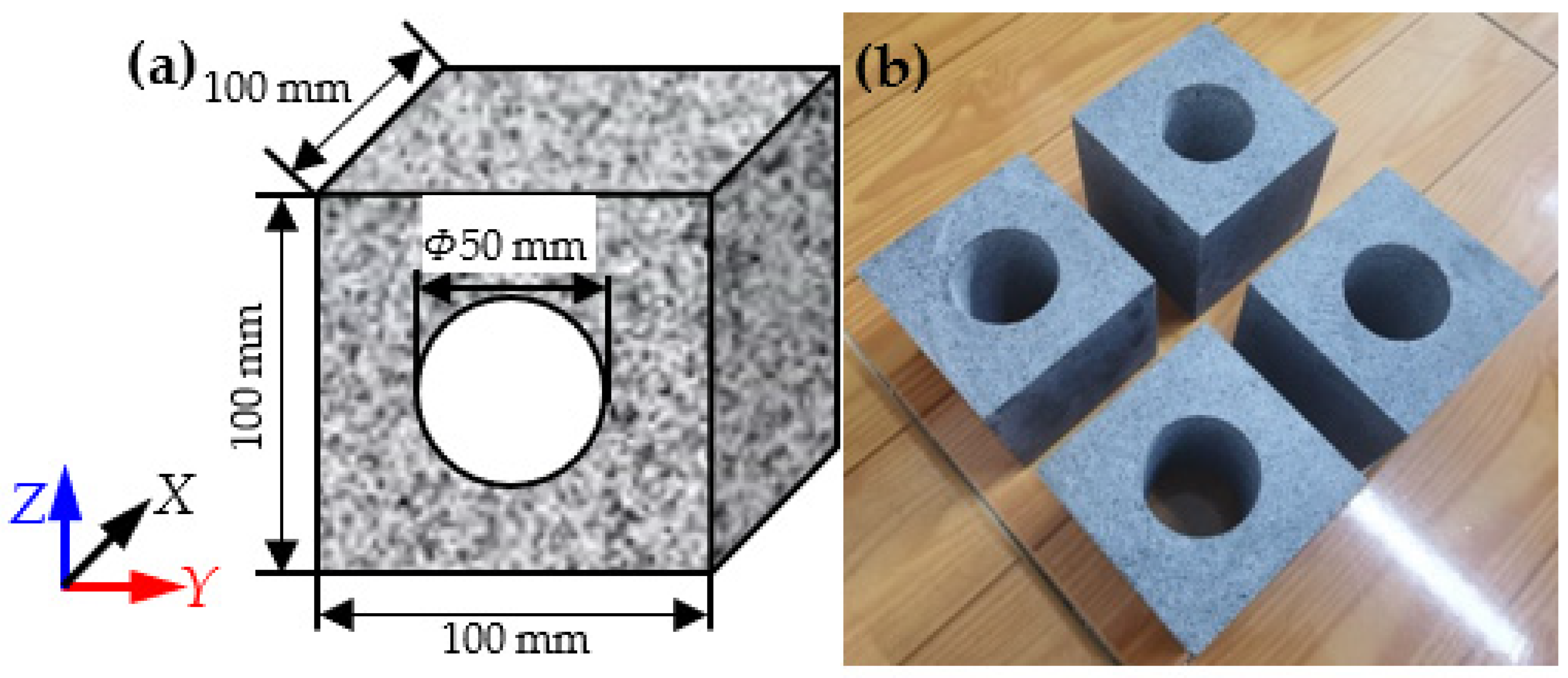
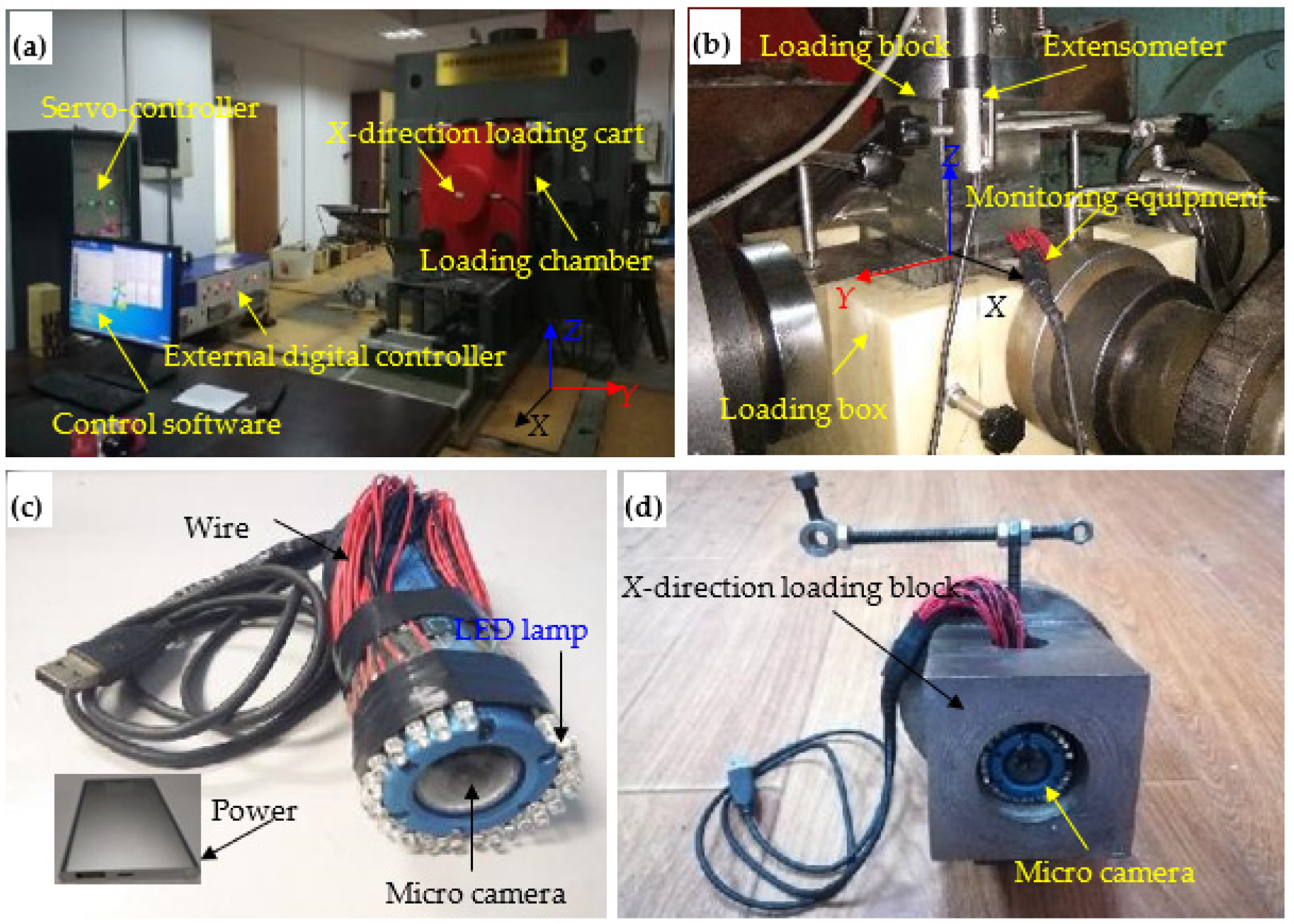

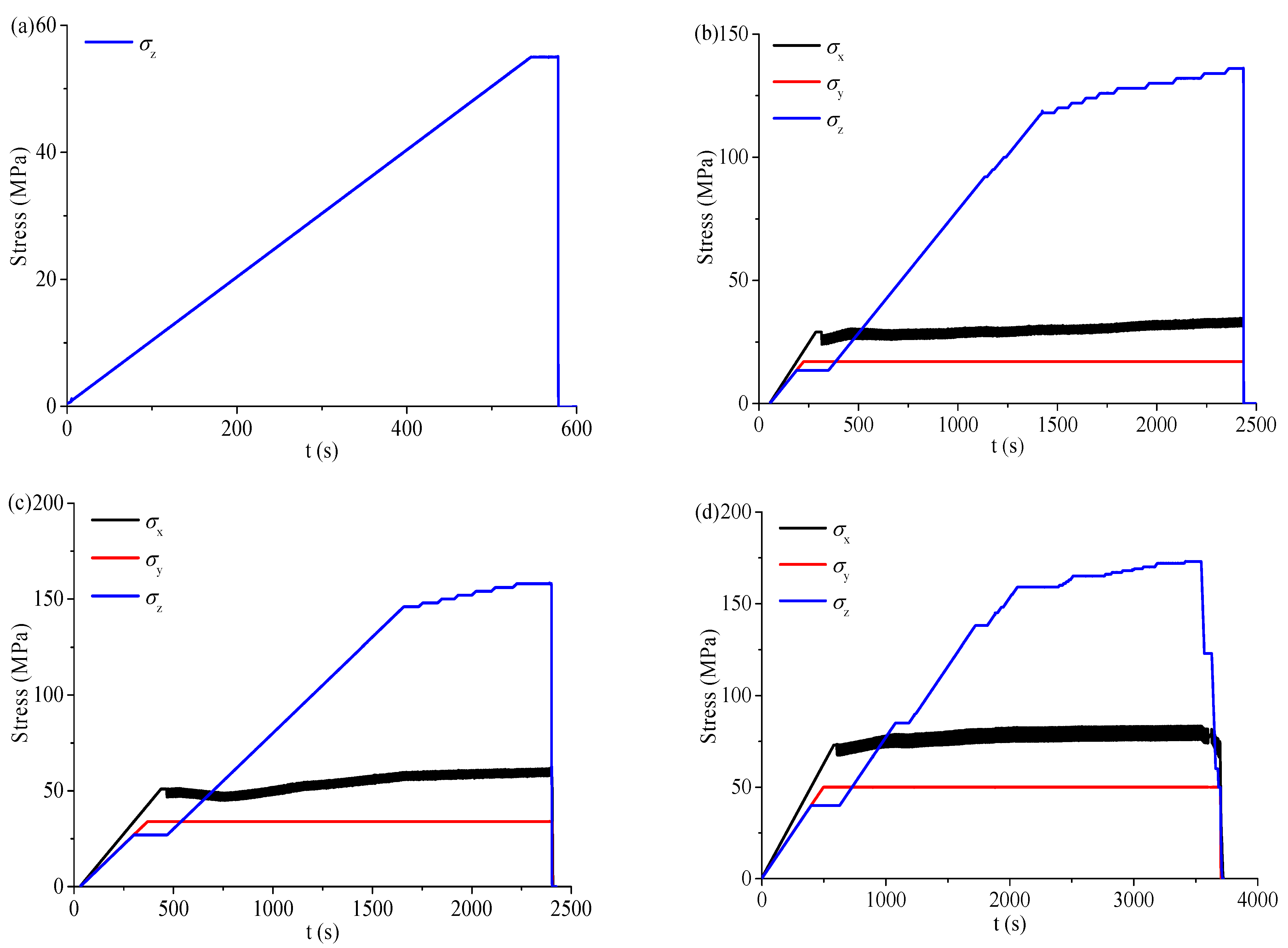



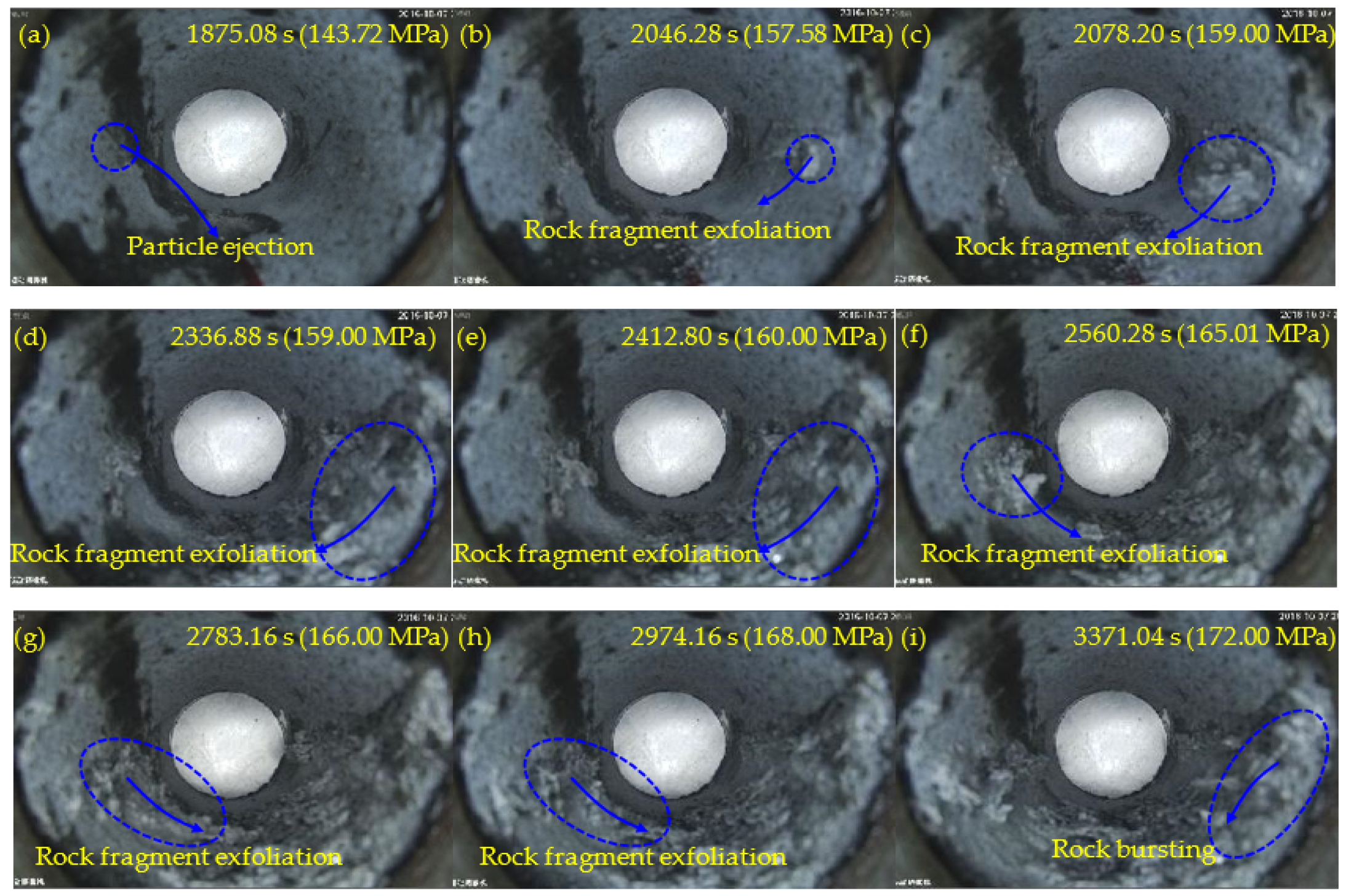
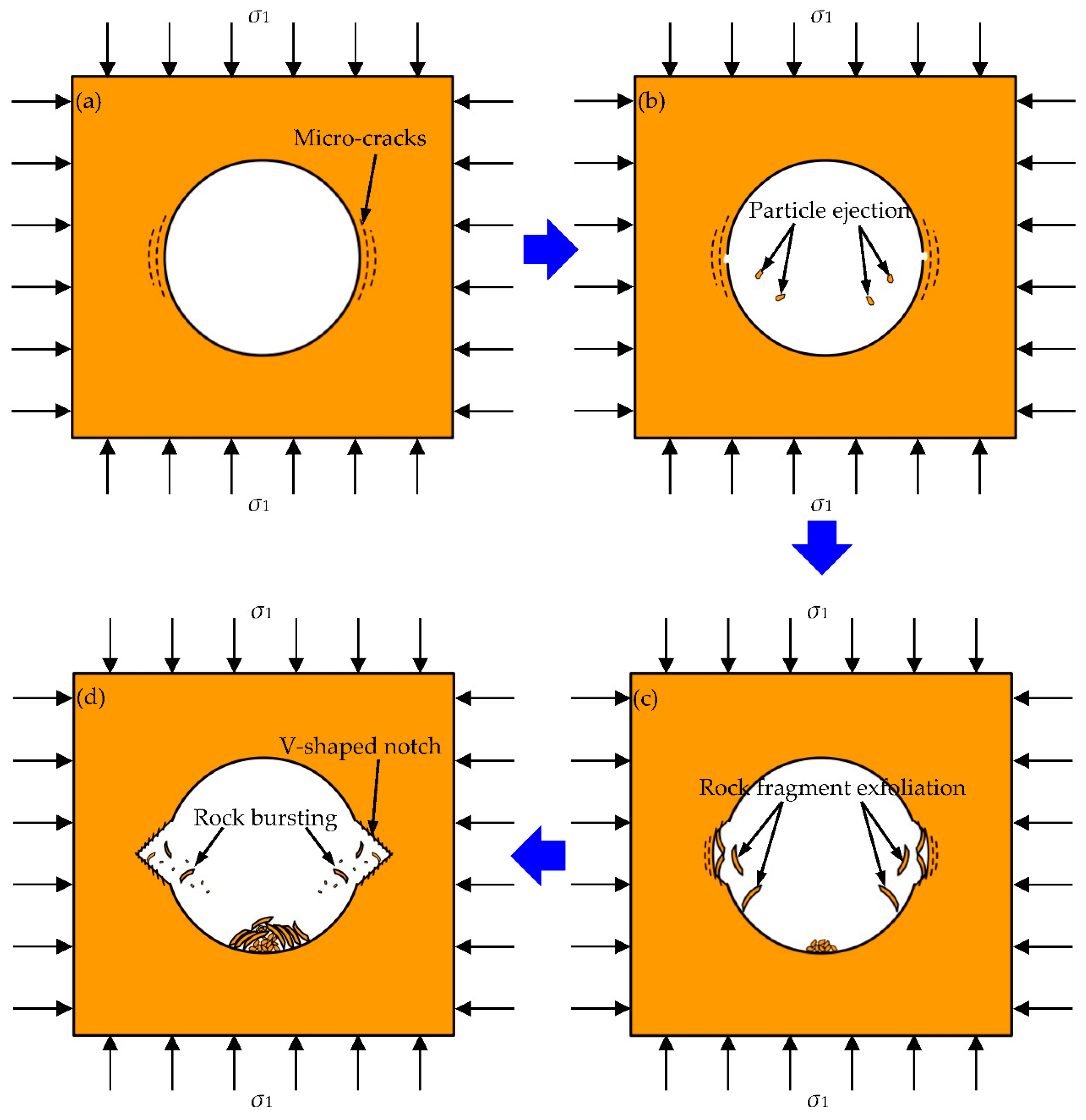
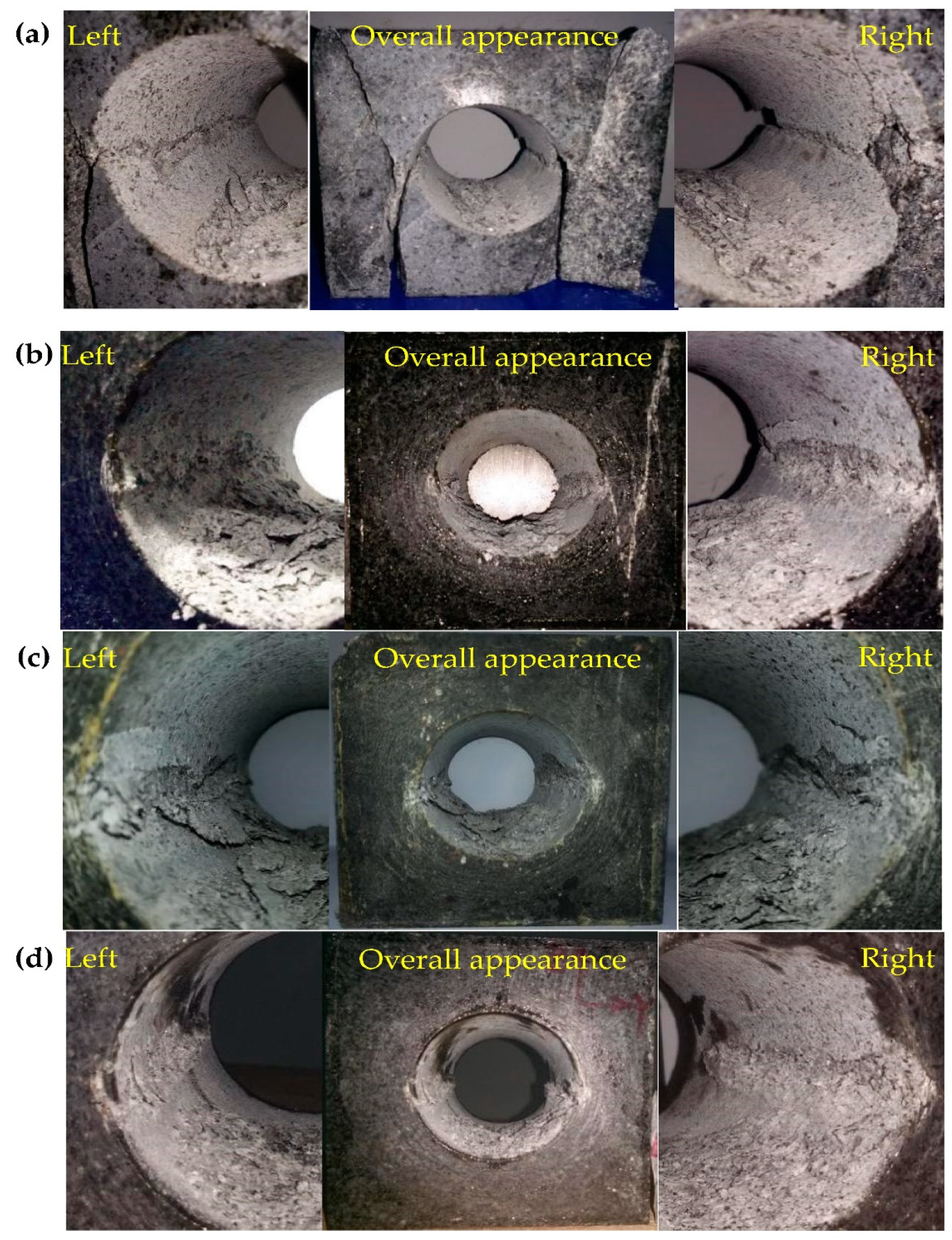


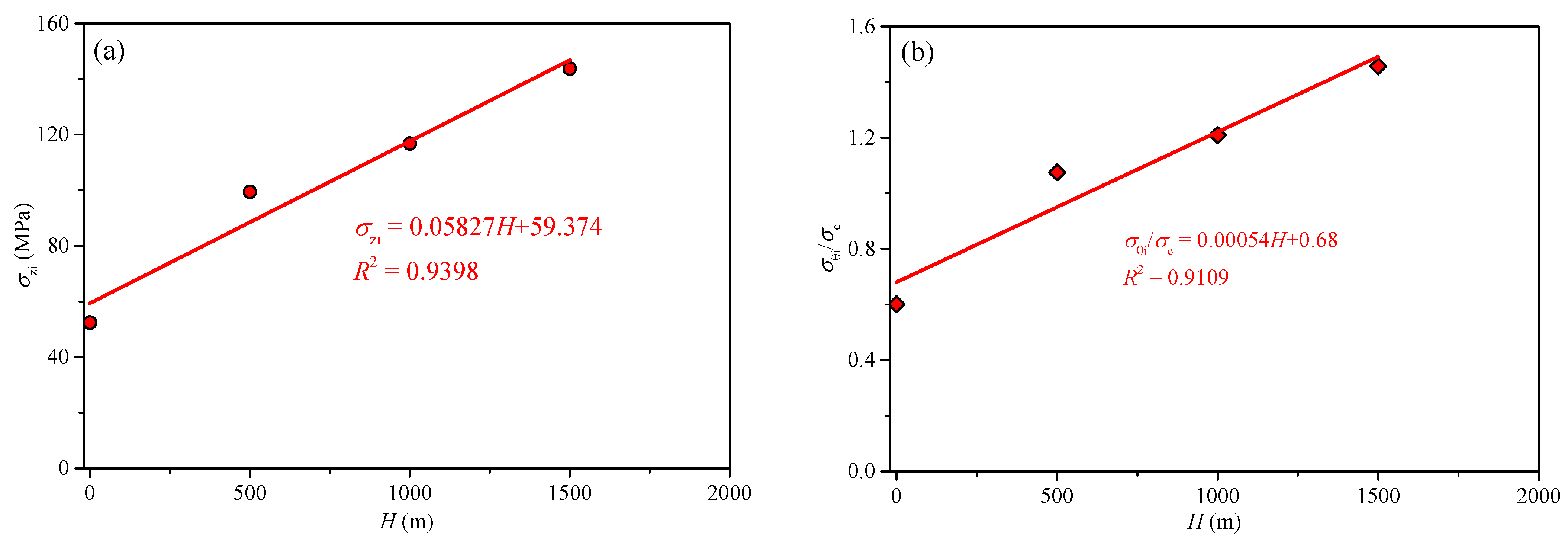

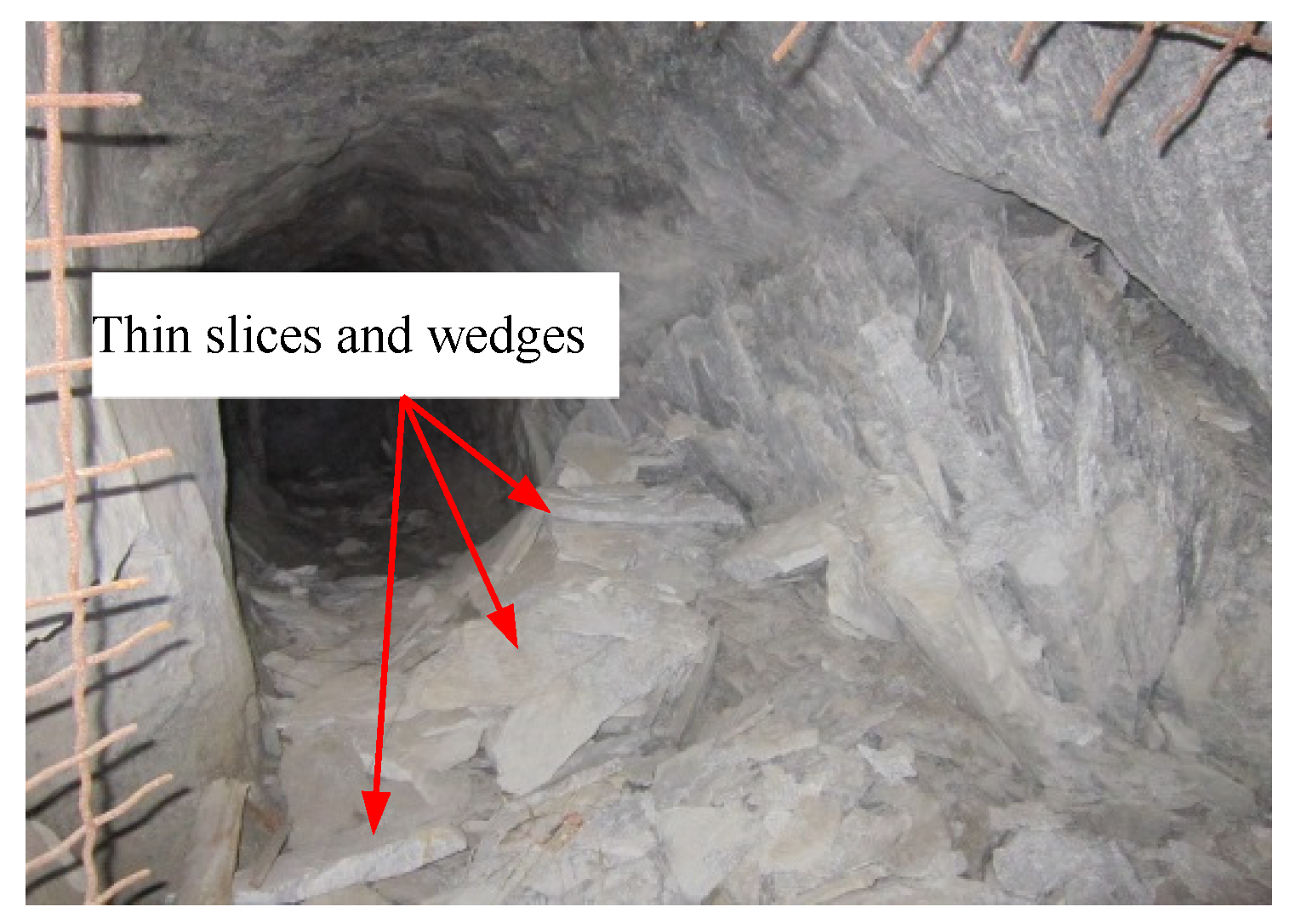
| H (m) | σy (MPa) | σzi (MPa) | σθi (MPa) | σθi/σc |
|---|---|---|---|---|
| 0 | 0 | 52.4 | 157.2 | 0.60 |
| 500 | 17 | 99.4 | 281.2 | 1.07 |
| 100 | 34 | 116.8 | 316.4 | 1.21 |
| 1500 | 50 | 143.7 | 381.1 | 1.46 |
Publisher’s Note: MDPI stays neutral with regard to jurisdictional claims in published maps and institutional affiliations. |
© 2022 by the authors. Licensee MDPI, Basel, Switzerland. This article is an open access article distributed under the terms and conditions of the Creative Commons Attribution (CC BY) license (https://creativecommons.org/licenses/by/4.0/).
Share and Cite
Si, X.; Peng, K.; Luo, S. Experimental Investigation on the Influence of Depth on Rockburst Characteristics in Circular Tunnels. Sensors 2022, 22, 3679. https://doi.org/10.3390/s22103679
Si X, Peng K, Luo S. Experimental Investigation on the Influence of Depth on Rockburst Characteristics in Circular Tunnels. Sensors. 2022; 22(10):3679. https://doi.org/10.3390/s22103679
Chicago/Turabian StyleSi, Xuefeng, Kang Peng, and Song Luo. 2022. "Experimental Investigation on the Influence of Depth on Rockburst Characteristics in Circular Tunnels" Sensors 22, no. 10: 3679. https://doi.org/10.3390/s22103679
APA StyleSi, X., Peng, K., & Luo, S. (2022). Experimental Investigation on the Influence of Depth on Rockburst Characteristics in Circular Tunnels. Sensors, 22(10), 3679. https://doi.org/10.3390/s22103679






